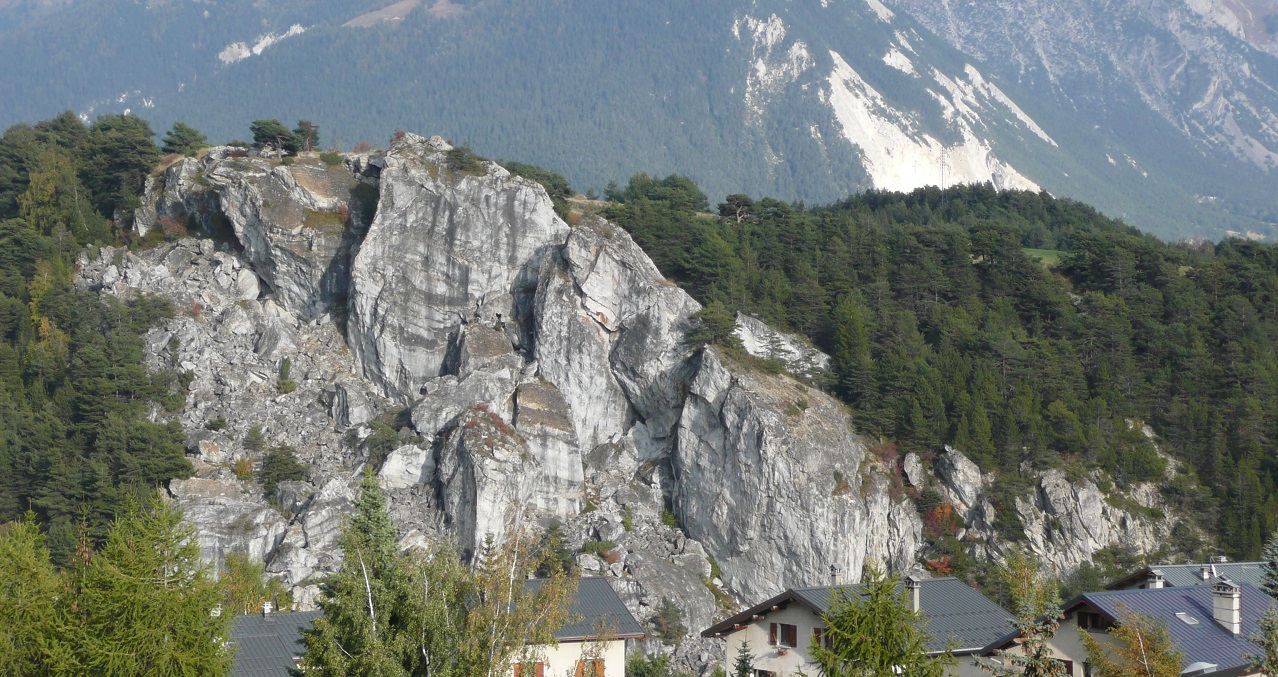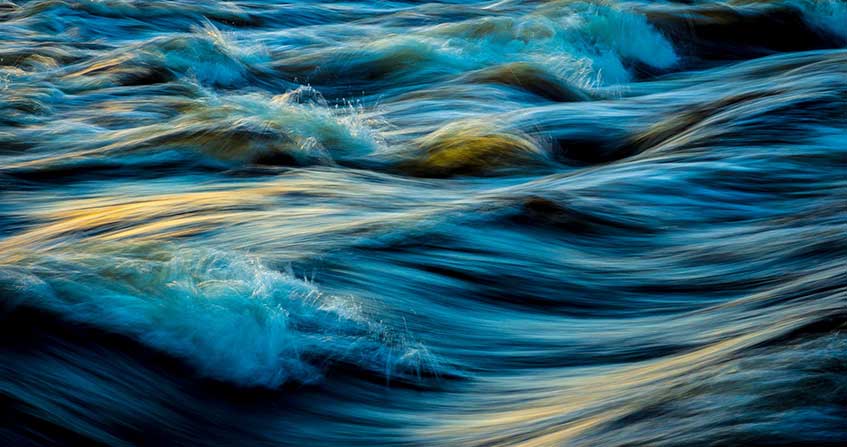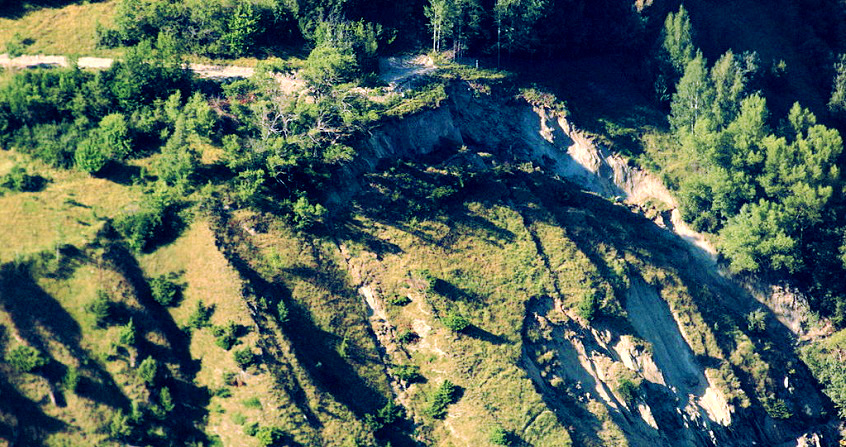为什么在急流中建筑大坝?
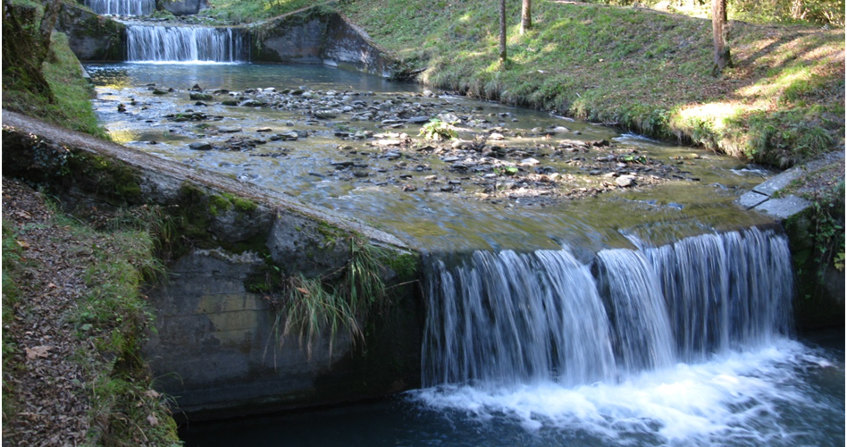
在阿尔卑斯山、庇里牛斯山和中央高原的源头,在急流中修建了成千上万的防洪拦沙坝。它们有何用途呢?它们限制了河流的侵蚀、降低了以及其他由急流带来的风险。这些构筑物在保护山地群落方面具有重要作用。它们通过稳定侵蚀过程,对环境产生影响。设计拦沙坝时需要了解它们对急流活动(特别是洪水)的影响。通过参考前人著作,本文回顾了急流拦沙坝的作用、起源和演变。我们将看到,像填满卵石的拦沙坝一样简单的构筑物,其建造目的、效果和功能可能因位置特征而截然不同。
1. 抵御洪水和水土流失的由来已久的需求
在溪流和急流附近,尤其是在国家森林中,山地徒步旅行者经常会注意到填满碎石和鹅卵石的水坝,尤其是在国家森林中。令人惊讶的是,这些由琢石、砖石或钢筋混凝土建造的结构出现在如此高的河道上。它们的用途与水力发电或老旧工厂没有直接关系:它们是防控侵蚀和山洪的构筑物。
山洪会造成相当大的损失,有时还会造成人员伤亡。一直以来,工程师们都很关注这些现象[1],这些现象与山脉的地貌形态有关,并随时间(主要是洪水期间)而演变。
在阿尔卑斯山衍生[1]的急流环境下,河道的整治和渠道化技术很快显现出局限性。1852年,在拿破仑三世建立法兰西第二帝国时,法国开始了山区的重新造林。这些政策,包括在大范围的牧区和被侵蚀地区重新造林,是几个因素共同作用的结果[2]:
- 法兰西第二帝国的集权式管理;
- 大型基础设施工程和保卫战略运输网络(公路和铁路)的项目;
- 半个多世纪的护林游说活动[3];
- 19世纪中期的一场水文危机(法国大多数主要河流系统发生大洪水,参见“水文测量:为什么要测河流流量,怎么测?”以及相关的焦点)。
1860年和1864年制定了这一雄伟的重新造林计划制定于1860年和1864年。在瑞士(1876年)、意大利(1877年)、奥地利(1884年)和日本(1897年)做出类似决定之前,这是首次重新造林计划。
1870年法兰西第二帝国灭亡后,1882年颁布了《山地恢复与保护法》(RTM)。新共和党大会听取了农村居民的意见,降低了重新造林的雄心:这项工作将集中在“由于土壤退化和已经出现的危险而必须进行的修复工作”。这意味着主要是急流河床、冲沟系统、廊道崩塌和滑坡。因此,新项目将更多地以土木工程为基础,而较少地以大量再造林作业为基础[4]。
从1882年到第一次世界大战之前,这段时间是“《山地恢复与保护法》(RTM)的黄金时代”。当时,一代又一代工程师已经掌握了修正一千多条急流的方法,他们使用的技术结合了林业工程、针对小型建筑的生物工程(称为梢枝捆和植被台的成束树枝)[5]以及针对堤坝、隧道、基岩和拦沙坝的土木工程[2]。这些是拦沙坝领域最显著和最具代表性的工程,也是本文的主题。
我们的山地协会传承了成千上万的防护结构。这些构筑物有时需要维护操作,有时被废弃,或者相反的是,使用新技术的构筑物得以实施,如开孔水坝[6]。只有当相关人群首先能够理解该系统的功能,即它对洪水和洪水活动的定性影响时,他们才能理解放弃、维持或改进一套防汛系统的决定。我们将通过参考前人的著作,回顾人类是如何产生修建拦沙坝这一想法的以及这一想法是如何随时间演变的。我们将看到,根据它的位置和特点,一个简单的结构,如填满卵石的大坝,不论是否能过滤,都可以用于各种各样的目的,并具有特定的效果和功能。
2. 先驱者
2.1 林业工作者

在19世纪,一个立场鲜明的护林游说团努力遏制了失控的森林砍伐,并开始山林的再绿化[3]。水情的监管作用一方面是对不同水流进行反复论证,另一方面则是在于侵蚀的预防[7]。
让吉恩·安东尼·法布尔(Jean Antoine Fabre,1748-1834)出版了一本开创性的书[8](图1)。这位早期的地物学家指出,对急流必须采取与普通河流不同的处理方法:通过重新造林来稳定沉积物的来源(见焦点栏目)。
亚历山大·苏雷尔(Alexandre Surell,1813-1887)吸纳并深化了法布尔和当时其他作家的思考,出版了《关于阿尔卑斯山脉急流的研究》一书[9](图2)。该书的第一部分是关于急流运动起源的权威专著,第二部分则是对坡地毁林和集权式山区重新造林的批判。
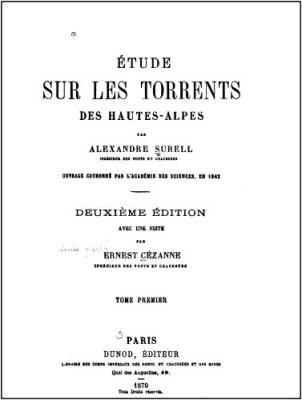
法布尔和苏雷尔一样,认为拦沙坝本身对于控制急流是不够的,但有趣的是,它可以稳定河岸和河床,从而促进重新造林。(见“焦点”栏目的第1节)。
2.2 拦河坝建造者
后来,西皮奥·格拉斯(1806-1873)[10],菲利普·布雷顿(1811-1892)[11]和米歇尔·科斯塔·德·巴斯特利卡(1817-1891)[12]重点研究拦沙坝的设计和功能。这些工程师试图将防护结构的设计集中在洪水过程中,强调了使防护系统适应流域特性的需求。
他们强调,不同于河流系统,洪流灾害的来源与固体输送过量有关,与液体排放过量无关。由此产生的灾害(泥石流、泥石洪流、泥流、洪水、泥沙沉积)是泥沙供给超过水流输送能力的结果,这与河段的坡度密切相关。格拉斯和布雷顿建议,冲积扇上的河道不应只是简单地筑堤:因为这仅仅意味着将同样的泥沙淤积问题推向下游。由于坡度不足,下游的河流系统(河流或农业排水沟)无法输送这种固体负荷,因此无论是否有堤坝,往往都会导致淤积,即抬高河床高度。如果河床宽度受到堤坝的限制,容纳泥沙的空间就会更小,那么河床高度就会增加得更加迅速——因此管理起来也就更加危险。
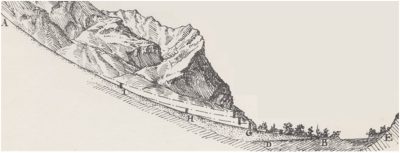
这些作者还认为,唯一的解决办法是对城市和农业地区上游的沉积物来源采取措施。他们承认,重新造林是有效的,但有时并不充分:(1)因为通过简单的重新造林来真正稳定洪流需要几十年的时间,所以对短期防护而言,拦沙坝作用更显著;(2)在极不稳定的流域,重新造林永远不够,应该辅之以拦沙坝。
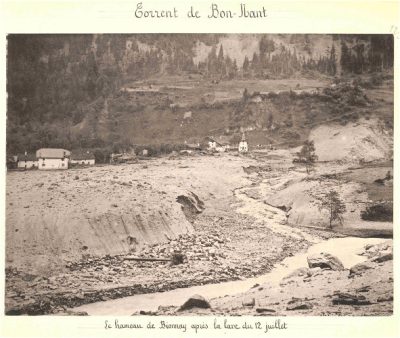
除了苏雷尔已经提到的渠道稳定化作用外,格拉斯、伯顿和巴斯特利卡还提出了拦沙坝可能具有的新功能:(1)滞留泥沙(见“焦点”栏目的第4节):泥沙在上游滞留,用专业术语表示为“冲积区”或“淤积区”(图3);(2)固结坡面(见“焦点”栏目的第2节):山谷底部填满的沉积物来形成阻塞,从而减缓滑坡的活动;以及(3)调控固体输送(见“焦点”栏目的第5节):通过观察急流河床存储和释放物质的自然规律,格拉斯(1857)[13]认为低坡度和宽区域的结构将倾向于通过暂时储存固体来缓冲泥沙运输。
3. 水域和森林
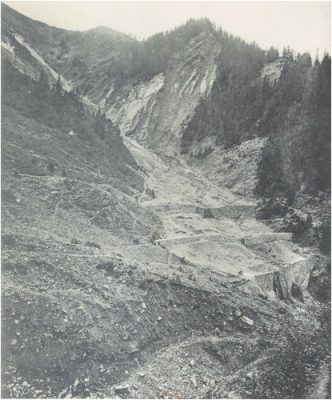
在1860年之后,在获得可以用于重新造林的土地后,水利林业局立即启动了第一批试验。普罗斯珀·德蒙齐(Prosper Demontzey)(1831-1898)、爱德蒙·蒂埃里(Edmond Thiéry)(1841-1918)、查尔斯·库斯(Charles Kuss)(1857-1940)、保罗·穆金(Paul Mougin)(1866-1939)和克劳德·伯纳德(Claude Bernard)(1872-1927)等授课者和践行者见证了山地保护和拦沙坝运用的历史。
之后,人们结合修复德蒙齐和蒂埃里山脉的首批经验,整理出了技术手册[14][15],库斯[16][17]和穆金[18]等人进而针对易于发生冰湖溃决洪水(图4和图5)、大型滑坡以及岩崩(图6)的特殊情况对手册进行完善。他们还使用排水或导流系统,以避免发生这种大规模的不稳定情况(图7)。
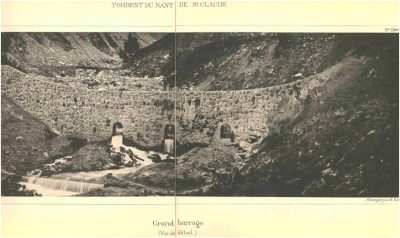
伯纳德所讲授的课程[15]代表了关于急流形态动力学及其控制技术的最前沿理解。课程重点总结了拦沙坝的一系列功能:
- 稳定河床
- 固结斜坡
- 减少河底坡度(见“焦点”栏目第3节)
- 滞留泥沙
- 调节固体输送
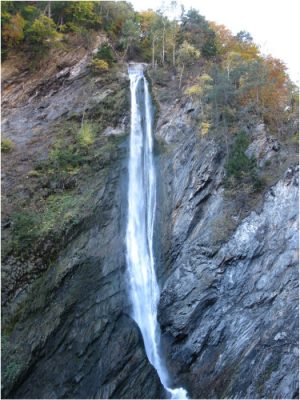
图8显示了一个标志性的分水岭,其中体现了这些与大坝相关的主要功能。
在两次世界大战之间,新工程的数量减少,大量尚未建成的建筑必须进行维护。战后出现了两项将彻底改变急流控制的技术:钢筋混凝土和土方机械[4]。
从1955年开始,钢筋混凝土的使用使悬臂坝的设计和建造成为可能。对于大型拦沙坝而言,悬臂坝比砌石重力坝造价更低[2]。钢筋混凝土还可以用来建造新的结构,如过滤坝和阻塞泥沙滞留盆地的开式拦沙坝。在1950-1960年代,过滤坝的概念被首次提出和测试[2]。在法国,在1966年水利林业局将职责移交给新的国家森林办公室之后,这些新的结构才逐渐走向主流。
4. 大量需要管理的构筑物
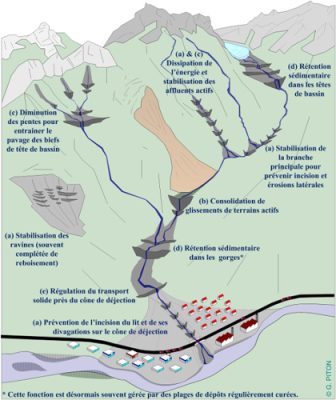
图片文字翻译(从上到下):
(a)&(c) Dissipation de J’énergie et stabilisation des affluents actifs. (a)&(c)能量耗散与活跃支流的稳定。
(d) Rétention sédimentaire dans les têtes de bassin. (d)集水区顶端的泥沙淤积。
(c) Diminution des pentes pourentrainer leavage des biefsde tète de bassin. (c)坡度的降低导致排水至盆地。
(a) Stabilisation de la branche principale pour Prévenir incision et érosions latérales. (a)稳定主要支流,防止切口和侧蚀。
(b) Censolidation deglissements de terrains actifs. (b)加固滑坡和不稳定的土地。
(a) Stabilisation des ravines (souvent complétée de reboisement). (a)稳定山谷(通常以植树造林为措施)
(d) Rétention sédimentaire dans les gorges. (d)峡谷沉积物滞留。
(e) Régulation du transport solide près du cône de déjection. (e)冲积扇附近固体运输的调节。
(a) Prévention de l’incision du lit et de ses divagations sur le cóne de déjection. (a)防止河床破坏及其在冲积扇上的河水泛滥。
• Cette fonction est désormais souvent gérée par des plages de dépôts régulièrement curées.
•这个功能现在通常由定期修整的河漫滩沉积物来调控。
1964年,前水利林业局根据RTM法律[21]在法国的26个省修建了92873座拦沙坝和堰、10条引流隧道和736公里的排水网。1966年,这些构筑的管理主要移交至国家森林办公室(ONF),部分和临时移交至农业主管部门(DDA),且在1971年ONF的某些部门要专门负责山地修复工作[22](ONF-RTM)。
在庇里牛斯山脉和阿尔卑斯山脉的11个山区,只有一部分工程得到国家的定期监测,其中包括ONF-RTM服务[21]。随着农村人口的减少、放牧的减少、小冰期结束以来的气候变化以及自发或人工造林的推进,许多流域的侵蚀已经减少。其他依旧非常活跃的侵蚀区域成为定期维护和投资的对象,以保护下游人口以及公路和铁路网等各种资产。
拦沙坝的管理目前主要从结构的有效性(目标和已达到的能力之间的适配性)和效率(总体效益和成本之间的适配性)两方面来考虑。这些分析与其他标准一样,旨在优化投资及维修资金;但它们的实施受到急流形态动力学的复杂性、大坝对洪水防控能力的难以量化性以及具有破裂风险的累积效应和潜在的级联效应的阻碍[23]。
因此,管理法国庞大的急流控制工程需要所有利益相关者(ONF-RTM、国家政府、地方民选官员、民众、风险管理者)更好地了解拦沙坝的潜在影响。虽然这些影响的量化和聚合是一个复杂且需要专业知识的课题,但我们主张每个人都能理解它们大致的原则。为此,本文提供了一个概括性的介绍。
参考资料及说明
[1] Vischer, D. L. 2003. History of flood protection in Switzerland, From the origins to the 19th century. OFEG, Water Series. http://assets.wwf.ch/downloads/histoire_protection_contre_crues__suisse.pdf
[2] Piton, G. 2016. Sediment transport control by check dams and open check dams in Alpine torrents. Grenoble Alpes University, IRSTEA – Centre de Grenoble. Chapter 1. https://tel.archives-ouvertes.fr/tel-01420209
[3] Kalaora, B., and A. Savoye. 1986. The pacified forest. Forestry and sociology in the 19th century. L’Harmattan, France.
[4] Brugnot, G. 2002. Development of forest policy and the emergence of mountain land restoration. Pages 23-30 in Annales des ponts et chaussées. https://doi.org/10.1016/S0152-9668(02)80031-6
[5] Genialp. 2012. Plant engineering in mountain rivers – knowledge and feedback on the use of plant species and techniques: vegetation of banks and wooden structures. Page (L. Bonin, A. Evette, P.-A. Frossard, P. Prunier, D. Roman, and N. Valé, Eds.). Europeen Union and Swiss Confederation. http://cemadoc.irstea.fr/cemoa/PUB00038614
[6] 专门用于捕获固体负荷(沉积物和木头)的结构,通常包括一个由土木工程结构封闭、通过开孔贯通的沉淀池,被称为“屏障过滤器”,参见Piton, 2016,出处同前。第2章和第3章。这些区域定期由土方机械清理。
[7] Durand, A. 2003. Role of the forest in floods. White Coal: 129-134.
[8] Fabre, J.-A. 1797. Essay on the theory of torrents and rivers. 342 p. Bidault Libraire, Paris. https://books.google.fr/books?id=fxkOAAAAAAQAAJ
[9] Surell, A. 1841. Study on the torrents of the Hautes Alpes. 280 p. . Library of the Imperial Corps of Civil Engineering and Mining, Paris. http://gallica.bnf.fr/ark:/12148/bpt6k96017215
[10] Gras, S. 1850. Presentation of a system for defending torrential rivers in the Alps and application to the Romanche torrent in the department of Isère. 112 p. Charles Vellot, Grenoble. http://www.e-rara.ch/doi/10.3931/e-rara-16678
[11] Breton, P. 1867. Brief on gravel dams in stream gorges. Paris. http://gallica.bnf.fr/ark:/12148/bpt6k6338240f
[12] Costa de Bastelica, M.. 1874. The torrents : their laws, their causes, their effects, the means to repress and use them, their universal geological action. Librairie Polytechnique, Paris. http://gallica.bnf.fr/ark:/12148/bpt6k28386p
[13] Gras, S. 1857. Studies on Alpine torrents. 108 p. F. Savy, Paris. http://www.e-rara.ch/doi/10.3931/e-rara-16676
[14] Demontzey, P. 1882. A Practical Treatise on Mountain Reforestation and Turfgrassing. 528 pp. Ministries of Agriculture and Trade and Public Works, Paris http://gallica.bnf.fr/ark:/12148/bpt6k6130912k
[15] Bernard, C. 1927. Mountain Restoration Course. 788 pp. École normale des eaux et forêts.
[16] Kuss, C. 1900a. Restoration and conservation of mountain land. The Glacial Torrents. 88 p. Imprimerie Nationale. http://gallica.bnf.fr/ark:/12148/bpt6k6357324x
[17] Kuss, C. 1900b. Restoration and conservation of mountain land. Landslides, landslides and dams. 61 p. Imprimerie Nationale. http://gallica.bnf.fr/ark:/12148/bpt6k64593256
[18] Mougin, P. 1900. Restoration and conservation of mountain land – consolidation of banks by diverting a torrent (Saint Julien torrent). 39 p. Imprimerie Nationale http://gallica.bnf.fr/ark:/12148/bpt6k6462342t
[19] 查尔斯库斯相册,三卷,日期不详(19世纪末)。格勒诺布尔中心IRSTEA档案馆。
[20] Water and Forests (1911a). “Restoration and conservation of mountain lands. Part two, Summary description of the restoration perimeters, Alps Region.” Under the direction of the Ministry of Agriculture – Directorate General of Water and Forestry. 215p. National Printing House.
[21] Carladous, S., G. Piton, J. Tacnet, F. Philippe, R. Nepote-Vesino, Y. Quefféléan, and O. Marco. 2016b. Protection against natural hazards in French mountains: historical analysis of actions and decision contexts in public forests. Pages 34-42 13th INTERPRAEVENT Conf. Process http://interpraevent2016.ch/assets/editor/files/IP16_CP_digital_CP.pdf
[22] ONF-RTM服务是仅在领域的某些特定区域存在的专门服务。如今,NFB在领域内由管辖范围大于部门的领土机构(51个机构)所代表。全国有320个地理单元供代表。
[23] Carladous, S. 2017. Integrated decision support approach based on the propagation of information imperfection in the expertise process – application to the effectiveness of torrential protection measures. Doctoral thesis. AgroParisTech, Ecole des Mines de Saint-Étienne.
环境百科全书由环境和能源百科全书协会出版 (www.a3e.fr),该协会与格勒诺布尔阿尔卑斯大学和格勒诺布尔INP有合同关系,并由法国科学院赞助。
引用这篇文章: PITON Guillaume (2024年3月9日), 为什么在急流中建筑大坝?, 环境百科全书,咨询于 2025年4月8日 [在线ISSN 2555-0950]网址: https://www.encyclopedie-environnement.org/zh/eau-zh/dams-on-torrents-why/.
环境百科全书中的文章是根据知识共享BY-NC-SA许可条款提供的,该许可授权复制的条件是:引用来源,不作商业使用,共享相同的初始条件,并且在每次重复使用或分发时复制知识共享BY-NC-SA许可声明。







